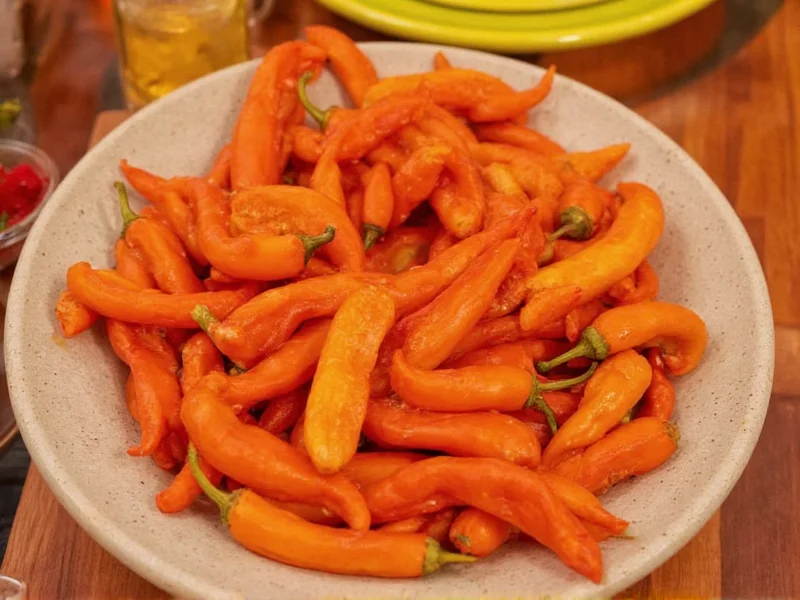Why Dehydrate Serrano Peppers?
Serrano peppers pack intense heat (10,000-23,000 Scoville units) and bright flavor perfect for salsas, sauces, and marinades. Dehydrating preserves their fiery character while concentrating flavors. Unlike jalapeños, serranos maintain crisp texture when dried, making them ideal for rehydrating in dishes or grinding into potent chili powder. Home dehydration beats store-bought versions by allowing complete control over freshness and avoiding preservatives.
Essential Equipment for Dehydrating Serranos
Choose your method based on available tools and time constraints:
| Method | Required Equipment | Best For |
|---|---|---|
| Electric Dehydrator | Mesh trays, sharp knife, cutting board | Consistent results, large batches |
| Oven Method | Baking sheets, parchment paper, oven thermometer | Urgent dehydration, no specialized equipment |
| Air Drying | String, needle, well-ventilated space | Traditional preservation, energy-free option |
Step-by-Step Dehydration Process
Preparation (All Methods)
Wear gloves to prevent skin irritation from capsaicin oils. Select firm, unblemished serranos without soft spots. Wash thoroughly and pat dry. Slice lengthwise into 1/8-inch strips for faster drying. Remove seeds only if you prefer milder heat - they contain significant capsaicin. Arrange pieces in single layer without overlapping.
Food Dehydrator Method
Set temperature to 135°F (57°C) - higher temperatures risk cooking rather than drying. Rotate trays every 4 hours for even airflow. Check after 8 hours; peppers should snap cleanly when bent. Total drying time typically ranges 8-12 hours depending on humidity. This method preserves maximum flavor and nutrients compared to other techniques for dehydrating serrano peppers at home.
Oven Dehydration Technique
Preheat oven to its lowest setting (usually 170°F/77°C). Place peppers on parchment-lined baking sheets. Prop oven door open 2-3 inches using a wooden spoon for airflow. Check every 2 hours, rotating pans for even drying. Total time ranges 6-10 hours. This approach works well when learning how to dehydrate serrano peppers without specialized equipment but consumes more energy.
Traditional Air Drying
Thread pepper strips onto cotton string through the stem end, leaving space between pieces. Hang in dark, well-ventilated area with 50-60% humidity. Ideal locations include pantry corners or shaded porch areas. Complete drying takes 2-3 weeks. Test readiness by snapping a piece - it should break cleanly without bending. This method for drying serrano peppers requires patience but yields complex flavor development.
Proper Storage of Dehydrated Serranos
Condition peppers before storage by placing in airtight container for 7-10 days to ensure no residual moisture remains. Store completely dry peppers in glass jars with oxygen absorbers or vacuum-sealed bags. Keep in cool, dark place away from heat sources. Properly stored dehydrated serrano peppers maintain peak quality for 6-12 months. Check periodically for moisture or mold - discard immediately if detected. Never store near strong-smelling foods as dried chilies readily absorb odors.
Culinary Applications for Dried Serranos
Rehydrate in hot water for 15-20 minutes before using in sauces or stews. For instant heat, crumble directly into soups or braises. Create custom chili powder by grinding dried serranos with cumin and garlic powder. Infuse dried peppers in vinegar for spicy condiments. When substituting in recipes, use 1 dried serrano equals 2 fresh peppers due to concentrated heat. Understanding how to use dehydrated serrano peppers expands your culinary options significantly compared to fresh-only cooking.
Troubleshooting Common Issues
Peppers turning brown: Oven temperature too high or excessive light exposure during drying. Use oven thermometer to verify actual temperature.
Mold development: Inadequate airflow or insufficient drying time. Increase spacing between pieces and extend drying duration by 25%.
Leathery texture: Peppers not fully dehydrated. Return to dehydrator for additional 2-4 hours. Complete dehydration ensures proper storage of dried serrano peppers without spoilage.
Frequently Asked Questions
Can I dehydrate serrano peppers with the seeds intact?
Yes, keeping seeds increases heat level significantly as they contain concentrated capsaicin. For milder dried serranos, remove seeds and white membranes before dehydration. Wear gloves during handling regardless of seed retention.
How do I know when dehydrated serrano peppers are fully dry?
Fully dehydrated serrano peppers should snap cleanly when bent, not bend or feel leathery. They'll appear shriveled with deepened color. Test multiple pieces from different trays as drying may be uneven. Properly dried serranos make a crisp sound when handled.
What's the best method for dehydrating serrano peppers quickly?
The food dehydrator provides fastest reliable results at 8-12 hours. Oven method works in 6-10 hours but uses more energy. Never rush dehydration - insufficient drying causes mold during storage. For urgent needs, slice peppers thinner (1/16 inch) to accelerate the process of dehydrating serrano peppers.
Can I rehydrate dried serrano peppers for fresh-like use?
Yes, soak dried serranos in hot water for 15-20 minutes until pliable. They won't regain exact fresh texture but work well in cooked dishes like sauces, soups, and stews. For salsas requiring crunch, rehydrated serranos won't substitute perfectly for fresh peppers.











 浙公网安备
33010002000092号
浙公网安备
33010002000092号 浙B2-20120091-4
浙B2-20120091-4